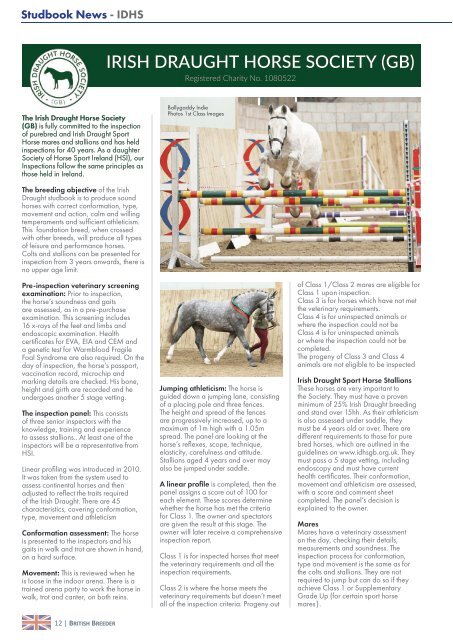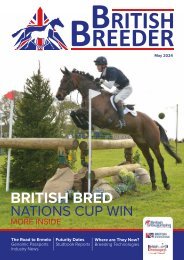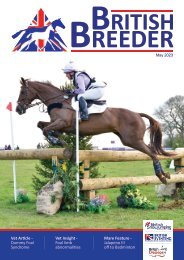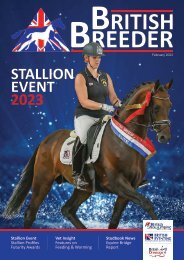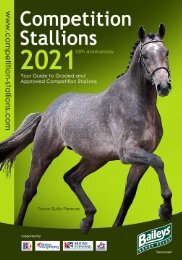British Breeder Dec 2023
British Breeder magazine including the full roundup of the British Breeding Futurity activities of 2023, Studbook news, top breeding articles and where are they now...........
British Breeder magazine including the full roundup of the British Breeding Futurity activities of 2023, Studbook news, top breeding articles and where are they now...........
Create successful ePaper yourself
Turn your PDF publications into a flip-book with our unique Google optimized e-Paper software.
Studbook News - IDHS<br />
IRISH DRAUGHT HORSE SOCIETY (GB)<br />
Registered Charity No. 1080522<br />
The Irish Draught Horse Society<br />
(GB) is fully committed to the inspection<br />
of purebred and Irish Draught Sport<br />
Horse mares and stallions and has held<br />
inspections for 40 years. As a daughter<br />
Society of Horse Sport Ireland (HSI), our<br />
Inspections follow the same principles as<br />
those held in Ireland.<br />
Ballygaddy Indie<br />
Photos 1st Class Images<br />
The breeding objective of the Irish<br />
Draught studbook is to produce sound<br />
horses with correct conformation, type,<br />
movement and action, calm and willing<br />
temperaments and sufficient athleticism.<br />
This foundation breed, when crossed<br />
with other breeds, will produce all types<br />
of leisure and performance horses.<br />
Colts and stallions can be presented for<br />
inspection from 3 years onwards, there is<br />
no upper age limit.<br />
Pre-inspection veterinary screening<br />
examination: Prior to inspection,<br />
the horse’s soundness and gaits<br />
are assessed, as in a pre-purchase<br />
examination. This screening includes<br />
16 x-rays of the feet and limbs and<br />
endoscopic examination. Health<br />
certificates for EVA, EIA and CEM and<br />
a genetic test for Warmblood Fragile<br />
Foal Syndrome are also required. On the<br />
day of inspection, the horse’s passport,<br />
vaccination record, microchip and<br />
marking details are checked. His bone,<br />
height and girth are recorded and he<br />
undergoes another 5 stage vetting.<br />
The inspection panel: This consists<br />
of three senior inspectors with the<br />
knowledge, training and experience<br />
to assess stallions.. At least one of the<br />
inspectors will be a representative from<br />
HSI.<br />
Linear profiling was introduced in 2010.<br />
It was taken from the system used to<br />
assess continental horses and then<br />
adjusted to reflect the traits required<br />
of the Irish Draught. There are 45<br />
characteristics, covering conformation,<br />
type, movement and athleticism<br />
Conformation assessment: The horse<br />
is presented to the inspectors and his<br />
gaits in walk and trot are shown in hand,<br />
on a hard surface.<br />
Movement: This is reviewed when he<br />
is loose in the indoor arena. There is a<br />
trained arena party to work the horse in<br />
walk, trot and canter, on both reins.<br />
Jumping athleticism: The horse is<br />
guided down a jumping lane, consisting<br />
of a placing pole and three fences.<br />
The height and spread of the fences<br />
are progressively increased, up to a<br />
maximum of 1m high with a 1.05m<br />
spread. The panel are looking at the<br />
horse’s reflexes, scope, technique,<br />
elasticity, carefulness and attitude.<br />
Stallions aged 4 years and over may<br />
also be jumped under saddle.<br />
A linear profile is completed, then the<br />
panel assigns a score out of 100 for<br />
each element. These scores determine<br />
whether the horse has met the criteria<br />
for Class 1. The owner and spectators<br />
are given the result at this stage. The<br />
owner will later receive a comprehensive<br />
inspection report.<br />
Class 1 is for inspected horses that meet<br />
the veterinary requirements and all the<br />
inspection requirements.<br />
Class 2 is where the horse meets the<br />
veterinary requirements but doesn’t meet<br />
all of the inspection criteria. Progeny out<br />
of Class 1/Class 2 mares are eligible for<br />
Class 1 upon inspection.<br />
Class 3 is for horses which have not met<br />
the veterinary requirements.<br />
Class 4 is for uninspected animals or<br />
where the inspection could not be<br />
Class 4 is for uninspected animals<br />
or where the inspection could not be<br />
completed.<br />
The progeny of Class 3 and Class 4<br />
animals are not eligible to be inspected<br />
Irish Draught Sport Horse Stallions<br />
These horses are very important to<br />
the Society. They must have a proven<br />
minimum of 25% Irish Draught breeding<br />
and stand over 15hh. As their athleticism<br />
is also assessed under saddle, they<br />
must be 4 years old or over. There are<br />
different requirements to those for pure<br />
bred horses, which are outlined in the<br />
guidelines on www.idhsgb.org.uk. They<br />
must pass a 5 stage vetting, including<br />
endoscopy and must have current<br />
health certificates. Their conformation,<br />
movement and athleticism are assessed,<br />
with a score and comment sheet<br />
completed. The panel’s decision is<br />
explained to the owner.<br />
Mares<br />
Mares have a veterinary assessment<br />
on the day, checking their details,<br />
measurements and soundness. The<br />
inspection process for conformation,<br />
type and movement is the same as for<br />
the colts and stallions. They are not<br />
required to jump but can do so if they<br />
achieve Class 1 or Supplementary<br />
Grade Up (for certain sport horse<br />
mares}.<br />
12 | BRITISH BREEDER


